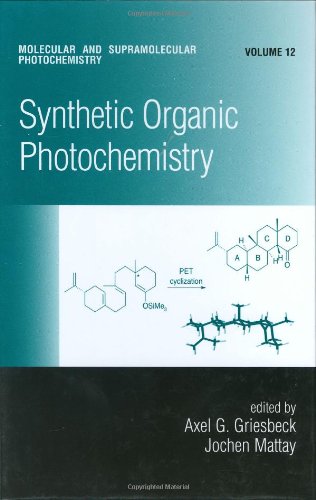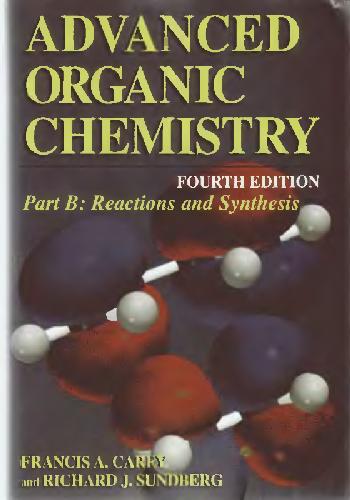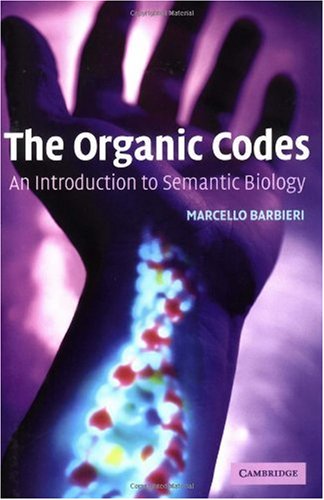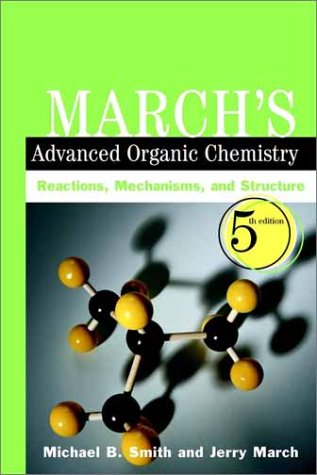Axel G. Griesbeck, Jochen Mattay9780824757366, 0-8247-5736-X
Table of contents :
Table of Contents……Page 0
dk1195fm……Page 2
Synthetic Organic Photochemistry……Page 4
Preface……Page 6
Contents……Page 9
Contributors……Page 11
1.1. INTRODUCTION……Page 13
REFERENCES……Page 20
2.1.1. General Summary……Page 22
2.1.3. Normal Behavior of 1,4-Biradicals……Page 23
2.1.4. beta-Cleavage of Radicals from 1,4-Biradicals……Page 24
2.1.5. Photoenolization of omicron-Alkylphenyl Ketones……Page 25
2.2.1. Acyclic Ketones……Page 26
2.2.2. alpha-Ketoesters……Page 27
2.2.4. beta-Cleavage of Radicals from 1,4-Biradicals……Page 28
2.2.5. omicron-Alkylphenyl Ketones……Page 29
2.2.6. Benzoate Esters: Electron Transfer……Page 30
2.3.1. Factors of General Importance……Page 31
2.3.2. Aliphatic Ketones……Page 32
2.3.3. Aryl Alkyl Ketones……Page 33
2.3.5. omicron-Alkylphenyl Ketones……Page 34
2.4. SYNTHETIC POTENTIAL: REACTIVITY AND SELECTIVITY PATTERNS……Page 35
2.4.1. Selectivity of Hydrogen Abstraction……Page 36
2.4.2. Chemoselectivity of 1,4-Biradical Reactions……Page 37
Acyclic ketones……Page 38
2.4.3. Stereoselectivity of 1,4-Biradical Reactions……Page 40
Cyclic Compounds……Page 41
2.4.5. omicron-Alkylphenyl Ketones……Page 42
2.4.7. Summary of Synthetic Potential……Page 43
2.5. REPRESENTATIVE PROCEDURES……Page 44
2.6. TARGET MOLECULES: NATURAL AND NONNATURAL PRODUCT STRUCTURES……Page 46
REFERENCES……Page 48
3.1. INTRODUCTION AND HISTORICAL BACKGROUND……Page 51
3.2. STATE OF THE ART MECHANISTIC MODELS……Page 53
3.3.1.1.1. Aliphatic Ketones……Page 58
3.3.1.2.1 Alicyclic Imides……Page 59
3.3.2.1. Photoinduced Single-Electron-Transfer (PET)……Page 60
3.3.2.3.2. Substituents in alpha-Position……Page 62
3.4.1.1. By beta-Hydrogen Abstraction……Page 63
3.4.1.2. By gamma-Hydrogen Abstraction and Subsequent Spin Center Shift……Page 64
3.4.2.1. By delta-Hydrogen Abstraction……Page 66
3.4.3.1. By epsilon-Hydrogen Abstraction……Page 71
3.4.4. Bi- and Tricyclic Compounds……Page 76
3.4.5. Macrocycles……Page 80
3.4.6. Photochemistry of Imides……Page 83
3.5.1. trans-1-Benzoyl-2-methyl-cyclopropane (12b)……Page 89
3.5.2. (2R,4aS,5aS,8R,9aR,9bR)-Perhydro-1-[(2R,3R)-3-hydroxy-3-phenyl-N-tosylprolyl]-2,8-diphenyl-2H,5H,8H-bis[1,3]dioxino[5,4-b:4′,5′-d]pyrroline (24)……Page 91
3.5.3. 1,2,3,6,7,8,9,10,11,12,13,14,15,21b-Tetradecahydro-21b-hydroxy-17H-[1,5]diazacyclo-heptadecino[2,1-a]isoindole-4,17(5H)-dione (96b)……Page 92
3.6. TARGET MOLECULES: NATURAL AND NONNATURAL PRODUCT STRUCTURES……Page 93
REFERENCES……Page 94
4.1. HISTORICAL BACKGROUND……Page 98
4.2. STATE OF THE ART MECHANISTIC MODELS……Page 99
4.3.1. Aromatic Aldehydes and Ketones……Page 100
4.3.2. Carboxylic Acid Derivatives and Nitriles……Page 102
4.3.3. alpha-Ketocarbonyl Compounds, Acyl Cyanides……Page 104
4.3.4. Enones and Ynones……Page 106
4.3.5. Quinones……Page 108
4.3.6. Alkenes, Alkyl-, and Aryl-Substituted……Page 109
4.3.7. Alkenes, Electron Donor-Substituted……Page 110
4.3.9. Allenes and Ketenimines……Page 113
4.3.10. Dienes and Enynes……Page 114
4.3.11. Furans……Page 115
4.3.13. Strained Hydrocarbons……Page 118
4.3.14. Alkenes, Electron Acceptor-Substituted……Page 119
4.4. SYNTHETIC POTENTIAL: REACTIVITY AND SELECTIVITY PATTERN……Page 120
4.4.1.1. Simple Diastereoselectivity……Page 123
4.4.1.2. Induced Diastereoselectivity……Page 130
4.4.2. Effect of Temperature on Diastereoselectivity……Page 131
4.4.3. Effect of Hydrogen Bonding on Diastereoselectivity of Paterno-Buchi Reaction……Page 133
4.4.5. Asymmetric Induction via Chiral Alkenes……Page 135
4.4.6. Intramolecular Paterno-Buchi Reactions……Page 138
4.5.2. Photocycloaddition of Benzaldehyde to 2,4-Dimethyl-5-methoxyoxazole with Subsequent Ring Opening……Page 140
4.6. TARGET MOLECULES: NATURAL AND NONNATURAL PRODUCT STRUCTURES……Page 141
REFERENCES……Page 142
5.1. INTRODUCTION……Page 149
5.2. MECHANISTIC DETAILS……Page 150
A. Nontethered Examples……Page 154
B. Tethered Photocycloaddition……Page 155
B. Tethered Alkenes……Page 158
A. Photocycloaddition of Silyl-Tethered Alkenes……Page 162
A. Cubane……Page 163
C. High Energy Compounds……Page 164
E. Terpenoids……Page 165
REFERENCES……Page 166
6.1. HISTORICAL BACKGROUND……Page 169
6.2. MECHANISTIC MODELS……Page 172
6.3. SCOPE AND LIMITATIONS……Page 176
6.4.1. The Reaction Regioselectivity……Page 178
6.4.2. The Excited State Involved in the Rearrangement……Page 180
6.5.1.1. 6,6-Diphenyl-2-diphenylmethylenebicyclo[3.1.0]hex-3-ene (53) (Sch. 18)……Page 182
6.5.2.1. endo-5-Methyl-3-phenylbicyclo[3.1.0]hexane-6-carbonitrile (58) (Sch. 20)……Page 183
6.5.2.2. (Ecyclo, EC–N)-2,2-Dimethyl-3-phenylcyclopropanecarbaldehyde oxime acetate (23) (Sch. 21)……Page 184
6.6. TARGET MOLECULES: NATURAL AND NONNATURAL PRODUCTS……Page 185
REFERENCES……Page 192
7.1. HISTORICAL BACKGROUND……Page 196
7.2. STATE OF THE ART OF MECHANISTIC MODELS……Page 197
7.3. SCOPE AND LIMITATIONS……Page 201
7.4. SYNTHETIC POTENTIAL: REACTIVITY AND SELECTIVITY PATTERN……Page 207
7.6. TARGET MOLECULES: NATURAL AND NONNATURAL PRODUCT STRUCTURES……Page 214
REFERENCES……Page 215
8.1. HISTORICAL BACKGROUND……Page 218
8.2. STATE OF THE ART, MECHANISTIC MODELS……Page 220
8.3. SCOPE AND LIMITATIONS……Page 223
8.4. SYNTHETIC POTENTIAL, REACTIVITY, AND SELECTIVITY PATTERNS……Page 228
Representative Experimental Procedures……Page 233
1. Photocyclization of an Enone to an Alkene: 6-Methylbicyclo[4.2.0]octan-2-one……Page 235
3. Photocycloaddition of 5,5-Dimethylcyclohex-2-enone (75) to 2,3-Dimethylbut-2-ene……Page 237
8.5. NATURAL- AND NONNATURAL TARGET MOLECULES……Page 238
REFERENCES……Page 242
9.2. STATE OF THE ART MECHANISTIC MODELS……Page 245
9.3. SCOPE AND LIMITATIONS……Page 246
Intermolecular [4+2] Cycloaddition……Page 248
Intramolecular [4+2] Cycloaddition of Dienes……Page 254
Photo-[4+2] Cycloadditions of Enones……Page 255
Additional [4+2] Cycloaddition Examples……Page 257
Intermolecular [4+4] Cycloaddition……Page 258
Intramolecular [4+4] Cycloaddition……Page 261
Photo-[4+2]-cycloaddition of Enone 102 and Furan……Page 266
Photocycloaddition of Tetraene 168……Page 267
(b) Monocarbocyclic Cyclo-octanoid Natural Products……Page 268
(d) Tricarbocyclic Cyclo-octanoid Natural Products: dicyclopenta[a,d]cyclo-octanes……Page 269
REFERENCES……Page 270
10.1. HISTORICAL BACKGROUND……Page 275
10.2. STATE OF THE ART MECHANISTIC MODELS……Page 276
10.3.1.1. PET Cyclization of Aromatic Oxoesters……Page 279
10.3.1.2. PET Cyclizations of Phthalimides……Page 281
10.3.2. Photocyclizations Initiated via Oxidative PET……Page 283
10.3.3. Photocyclizations Initiated via Reductive PET……Page 289
10.4.1. Regioselectivity……Page 291
10.4.2. Diastereoselectivity……Page 293
10.4.3. Enantioselectivity……Page 294
10.5.1. General Remarks……Page 295
10.5.2. Radical Cationic Photocyclization of the Oligopeptide (23) [>345nm Photolysis on a 0.1 mmol Scale]……Page 296
10.5.4. Photodecarboxylative Cyclization of the N-Phthaloylanthranilic Acid Amide of L-Leucine (81) [308nm XeCl Excimer Photolysis on a 32 mmol Scale]……Page 297
REFERENCES……Page 299
11.1. HISTORICAL BACKGROUND……Page 304
11.2.1. State of Art Mechanistic Models……Page 306
11.2.2. Chemoselectivity……Page 308
11.2.3. Stereochemistry……Page 309
11.2.4.1. Cyclic Dienes……Page 315
11.2.4.2. Acyclic Dienes……Page 318
11.2.4.3. Aromatic Compounds……Page 322
11.2.4.4. Vinylarenes……Page 324
11.2.4.5. Heterocyclic Systems……Page 325
11.2.4.5.1. Furans……Page 326
11.2.4.5.2. Pyrroles……Page 328
11.2.4.5.4. Heterocycles with More than One Heteroatom……Page 330
11.2.5.1. Reduction (a,b,c)……Page 334
11.2.5.2. Thermolysis (d,e)……Page 335
11.2.5.3. Metal-Promoted Decompositions (d)……Page 336
11.2.5.5. Acid- and Base-Catalyzed (g) Reactions……Page 338
11.2.6. Target Molecules……Page 341
11.2.7. Synthetic Procedures: An Example……Page 343
11.3.1. Scope and Limitations……Page 344
11.3.2. State of Art Mechanistic Models……Page 346
11.3.3. Chemoselectivity and Diastereoselectivity……Page 347
11.3.4.1. Fragmentation……Page 352
11.3.4.2. Nucleophilic Transformations……Page 353
11.3.4.3. Rearrangements……Page 356
11.3.5. Chemiluminescence……Page 357
REFERENCES……Page 360
12.1. HISTORICAL BACKGROUND……Page 369
12.2. STATE OF THE ART MECHANISTIC MODELS……Page 370
12.3. SCOPE AND LIMITATIONS……Page 372
12.4. SYNTHETIC POTENTIAL: REACTIVITY AND SELECTIVITY PATTERN……Page 381
12.5. REPRESENTATIVE EXPERIMENTAL PROCEDURES……Page 386
12.6. TARGET MOLECULES: NATURAL AND NONNATURAL PRODUCT STRUCTURES……Page 389
REFERENCES……Page 390
13.2.1. Generation of Nitrenes……Page 395
13.2.2. Properties of Nitrenes……Page 396
13.3.2. 1-Alkenyl Nitrenes……Page 398
13.3.4. Heteroaryl Nitrenes……Page 399
13.3.5. Acyl Nitrenes……Page 401
13.4.3. Alkylcarbonyl Nitrenes……Page 404
13.4.4. Addition of Aroyl Nitrenes to Nonpolar and Electron Deficient pi-Bonds……Page 407
13.4.5. Formation of Five-Membered Rings……Page 409
13.4.6. Stereochemistry……Page 413
13.4.6.1. Chiral Acylazides……Page 414
13.4.6.2. Chiral Alkenes……Page 415
Procedure A……Page 417
REFERENCES……Page 418
14.1. INTRODUCTION……Page 421
14.2.1. Direct Irradiation……Page 422
14.2.2. Sensitized Isomerization……Page 425
14.3. DIRECT IRRADIATION OF CYCLOALKENES……Page 426
14.4.1. Cyclohexenes and Cycloheptenes……Page 429
14.4.2. Cyclo-octenes……Page 431
14.4.3. Miscellaneous Cycloalkenes……Page 433
14.5.1. Cyclo-octene……Page 436
14.5.2. Cyclo-octene Derivatives……Page 438
14.5.3. Cyclohexene and Cycloheptene……Page 439
14.6.1. Stilbenes……Page 441
14.6.2. Stilbene and Styrene Derivatives……Page 442
14.7.1. (E)-Cyclo-octene……Page 446
14.7.3. (Z )-Stilbene……Page 447
14.8. CONCLUSION……Page 448
REFERENCES……Page 449
15.1. HISTORICAL REMARKS……Page 457
15.2. STATE OF THE ART MECHANISTIC MODELS……Page 458
15.2.1. Fragmentation of an Excited State……Page 459
15.2.3. Fragmentation via a Radical Ion……Page 461
15.3. SCOPE AND LIMITATION……Page 462
15.4.1.1. H/D Exchange……Page 463
15.4.1.3. Substitution of Alcohols and Ethers……Page 464
15.4.1.4. Substitution of Other Oxygen-Linked Groups……Page 466
15.4.1.5. Substitution of Nitrogen-Linked Groups……Page 467
15.4.1.6. Substitution of Other Groups……Page 468
15.4.2.1. Benzylation of Arenes……Page 471
15.4.2.2. Benzylation of Alkenes……Page 474
15.4.2.3. Benzylation of Carbonyl, Carboxamide, and Iminium Groups……Page 475
15.4.3. Benzylic Oxidation or Functionalization……Page 477
15.4.4. Reactions of Arylated Three- and Four-Membered Cyclic Compounds……Page 479
15.4.5. Further Applications of Benzylic Photocleavage……Page 480
Modern Procedures……Page 482
15.6. TARGET MOLECULES: NATURAL AND NONNATURAL PRODUCT STRUCTURES……Page 485
REFERENCES……Page 489
16.1. HISTORICAL REMARKS……Page 499
16.2. STATE OF THE ART MECHANISTIC MODELS……Page 500
16.3.2. Nucleophiles: Carbanions……Page 503
16.3.3. Other Nucleophiles……Page 505
16.3.4. Solvents……Page 506
16.4.1. Ketone Enolate Ions……Page 507
16.4.2. Carbanions Derived from Esters, Acids, and N,N-Disubstituted Amides……Page 510
16.4.3. Indole Syntheses……Page 512
16.4.4. Tandem Ring Closure—SRN1 Reactions……Page 514
16.4.5. Reactions with Me3Sn– Ions and Ensuing Processes……Page 516
16.5.1. Reactions in Liquid Ammonia……Page 520
17.5.3. Synthesis of 5,6,7-Trimethoxy-3-methyl-1(2H)-isoquinolone……Page 521
16.5.5. Photostimulated Reactions with Me3Sn- Ions……Page 522
16.6.2. 3-Methyl-2H-isoquinolin-1-one Derivatives……Page 523
16.6.3. Benzo[c]chromen-6-one Derivatives……Page 524
16.6.5. Cephalotaxinone……Page 525
16.6.7. (±)Tortuosamine……Page 526
REFERENCES……Page 527
17.1. HISTORICAL BACKGROUND……Page 532
17.2. STATE OF THE ART MECHANISTIC MODELS……Page 533
17.3.2. ortho-Photocycloaddition……Page 534
17.3.3. para-Photocycloaddition……Page 537
17.4.1. Meta Photocycloaddition……Page 538
17.4.2. Ortho Photocycloaddition……Page 545
17.5.1. meta-Photocycloaddition……Page 547
17.5.3. Para Photocycloaddition……Page 548
17.6. TARGET MOLECULES: NATURAL AND NONNATURAL PRODUCT STRUCTURES……Page 549
REFERENCES……Page 552
18.1 INTRODUCTION……Page 556
18.2. PHOTOCHEMISTRY OF VISION–PROTEIN AS A CONFINING MEDIUM……Page 557
18.4. ORGANIZED MEDIA MIMIC A PROTEIN: SELECTED EXAMPLES……Page 560
18.5. REACTION CAVITY CONCEPT……Page 567
18.5.1. Characteristics of a Reaction Cavity Illustrated with Examples: Boundary……Page 571
18.5.2. Characteristics of a Reaction Cavity: Interface……Page 575
18.5.3. Characteristics of a Reaction Cavity: Free Volume……Page 578
18.5.4. Characteristics of a Reaction Cavity: Presence of Weak Forces……Page 582
18.6.1. Microheterogeneity in Organized Media……Page 586
18.6.2. Failure of Rule of Homology……Page 589
18.6.3. New Mechanisms may Emerge in a Confined/Organized Media……Page 593
18.7. POWER OF ORGANIZED MEDIA ILLUSTRATED WITH THEIR INFLUENCE ON ASYMMETRIC PHOTOREACTIONS……Page 596
18.7.1. Crystalline Media……Page 597
18.7.1.1. Achiral Molecules as Chiral Crystals……Page 598
18.7.1.2. The Ionic Chiral Auxiliary Approach……Page 601
18.7.2. Achiral Molecules within Chiral Hosts……Page 602
18.7.3. Enantioselective Photoreactions within Zeolites……Page 608
REFERENCES……Page 614







Reviews
There are no reviews yet.